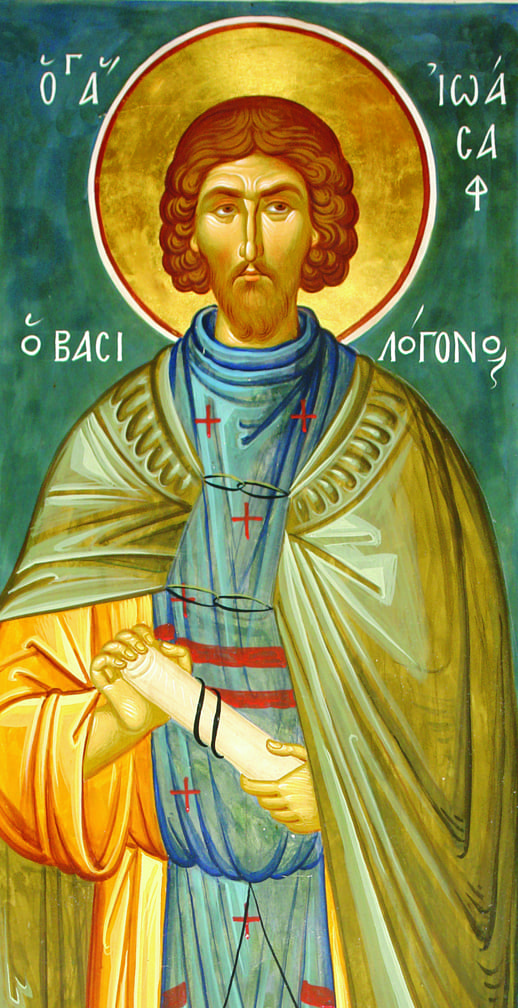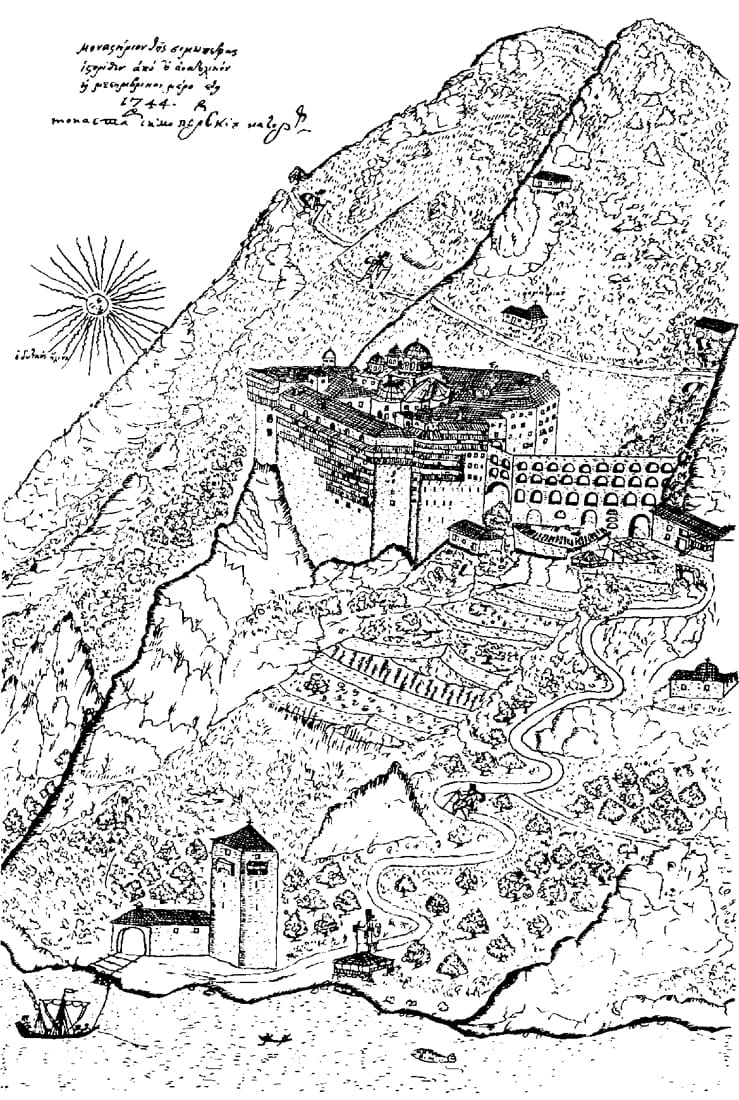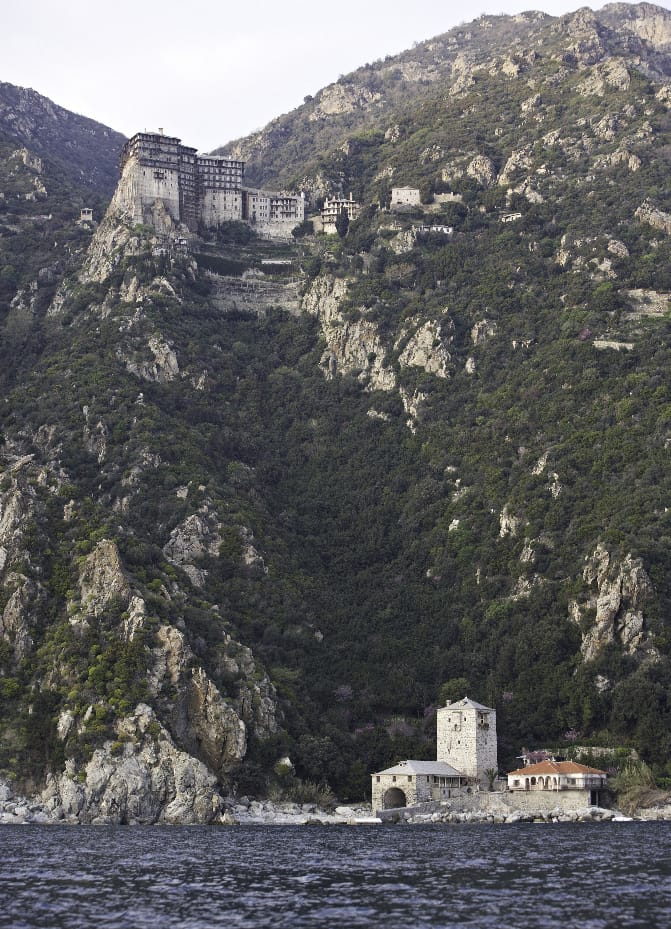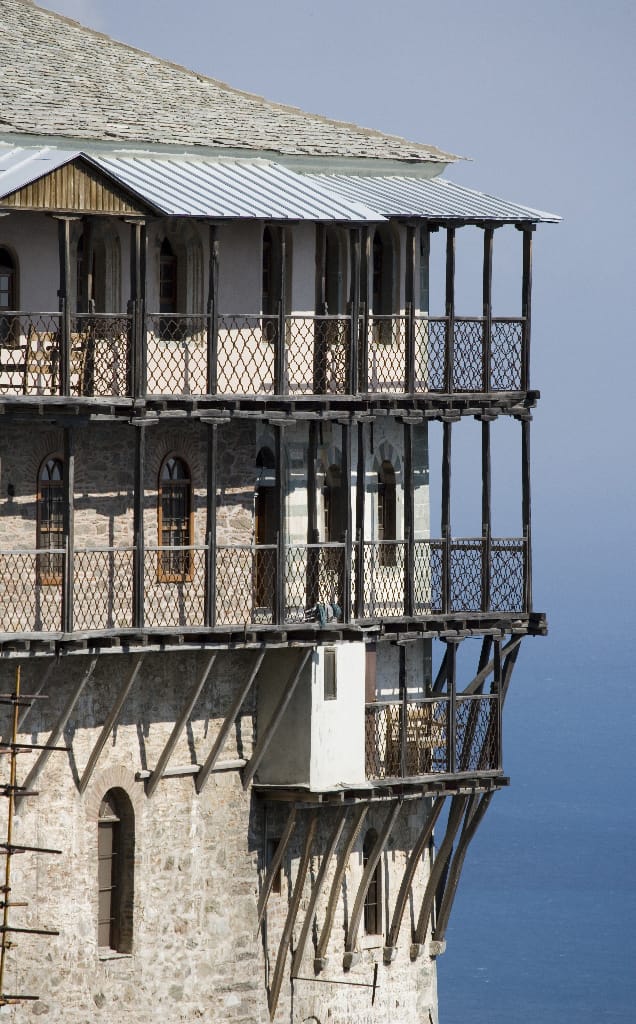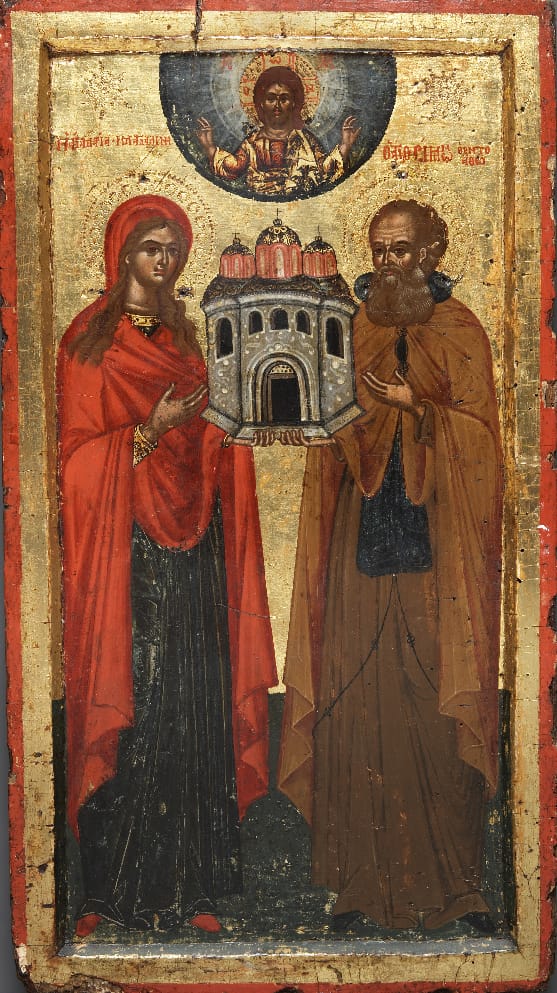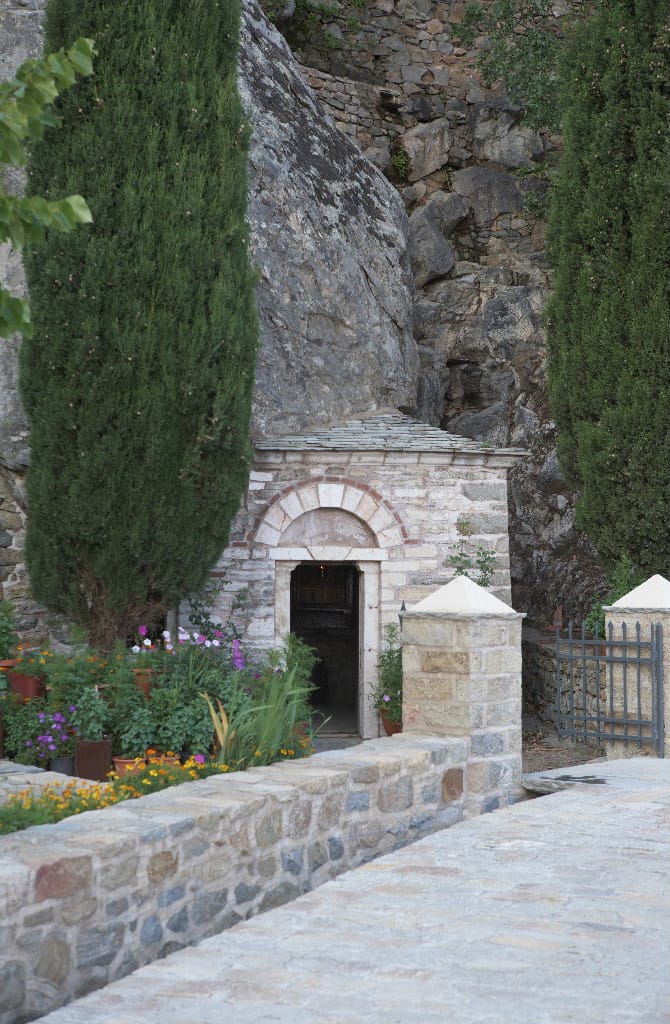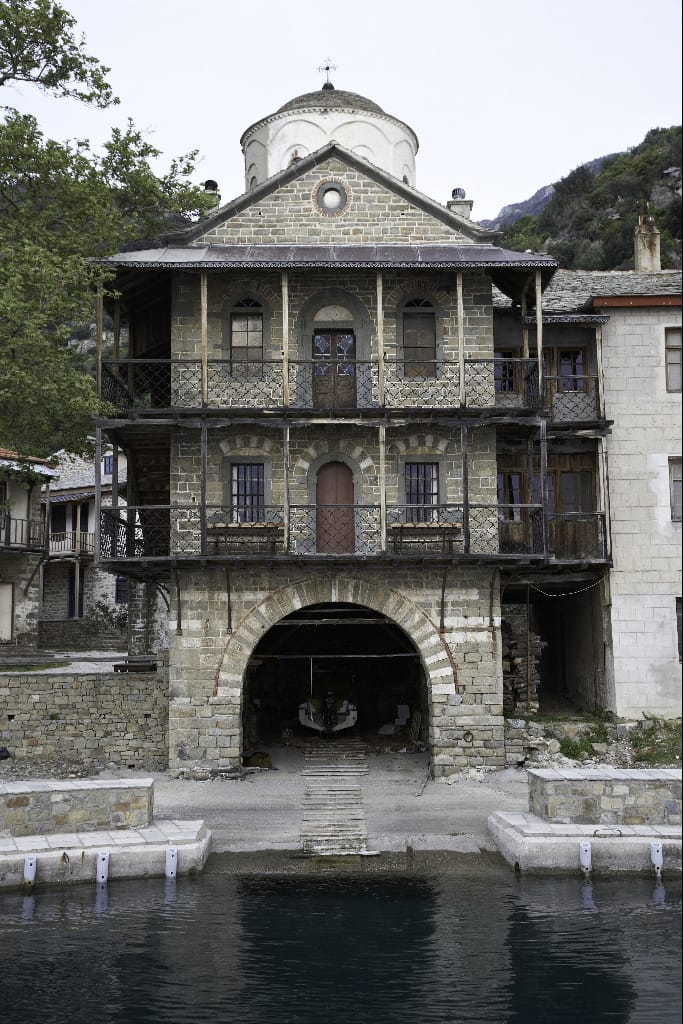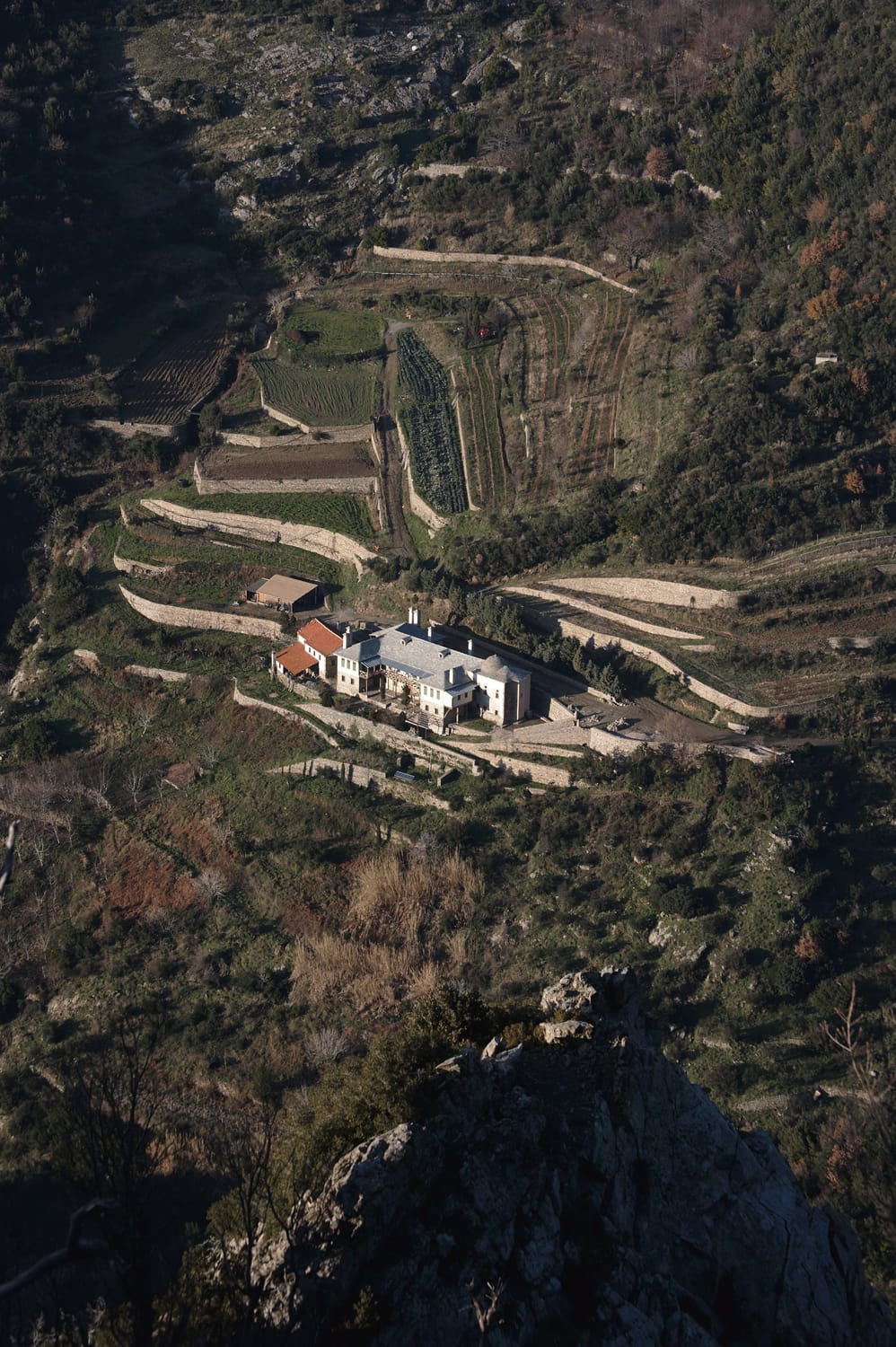Simonopetra
The history of the monastery
Simonopetra Monastery ranks 13th in the hierarchy of the Athonian Community. Its existence is closely related to the figure of its founder, St. Simon Myroblyte [the Athonite]. The saint was active during the Latin Empire [Frankish rule] period (1204-1261). St. Simon lead his ascetic life in the cave across Simonopetra. He prayed day and night and, during the Advent before Christmas, for many nights he dreamt “a star that seemed to be separating from the sky and standing over the stone across the cave, where the monastery is now built”. Finally, on Christmas night “it seemed to him that he was in Bethlehem, Judea; it was as if he could see our Lord swaddled in the manger” and “a divine voice came from heaven”, ordering him to found on the rock, where “light composed from a star” was shed, his own New Bethlehem, present-day Simonopetra.
The new monastery was named New Bethlehem by its founder, but the name did not prevail, since, during the glorious and pious period following his repose, the monastery established the name of St. Simon, verifying thus the prediction of the Mother of God. She had discouraged him from departing from this place, telling him: “I shall glorify this place in your name”.
Following St. Simon’s repose, his figure is still dominating the place and continues to influence the fortune and history of the Monastery. In the 1365-1371 period, the Monastery entered a new phase, with its second founder/patron, the Serb Jovan Uglješa (Јован Угљеша), Despot of Serres. The Serbian despot had heard about the “small monastery of Kyr Simon, recently departed in myrrh and glory” and wanted to benefit “those of simple mind who resided there in the name of Christ, the true sons and heirs to the kingdom of heaven” or, according to tradition, following the miraculous cure a close relative of his received at the monastery, Jovan sought permission to turn the small house into a proper monastery, building it “in his own memory” at that “desert-like” place. Following the innovative intervention and donations by Jovan Uglješa, Simonopetra came to know days of flourish and his name is always remembered as that of a ‘ktitor’ [founder] of the monastery.
Oral tradition has it that, at the same time, Jovan Uroš Nemanjić, a man of royal birth [John Ouresis Doukas Palaiologos or Joasaph of Meteora] was also leading an ascetic life at Simonopetra, not revealing his noble origins. He is one of the first monastery Saints, after St. Simon, appearing in the Ktitor’s icon of the Katholikon; he appears holding a cross with the inscription “St. Joasaph, son of the king and founder, a monk within this Monastery”. This born-to-royalty Saint is honoured on the same feast day as that of St. Simon’s, i.e., on 28 December.
On 11 December 1580 the first devastating fire broke out. A thunder “in one stroke instantly turned into ash and completely destroyed” the cells, the heirlooms, the books, the vestments, the chrysobulls, the sigilla. The walls of the monastery collapsed down to their foundations, “like Jericho’s walls in the past” and “only the Church remained safe and sound, like the three youths in the flames of Babylon”. Most monks escaped using ropes to come down the rocks, but some of them met a martyr’s death.
In 1725-6, the Russian traveller Vasily [Grigoryevich Grigorovich] Barsky first visited the monastery and was astonished at the bold architectural edifice of Simonopetra, wondering “how and in what manner it had been constructed there and how it could be held in position”. Twenty years later, in 1744, he visited again and recorded in detail the state of the monastery, presenting an exceptional plan of it and the area surrounding it, as viewed from the south east side. Several years later, according to the Monastery code “on 15 April, 1762, a Serbian spiritual clergyman arrived, Father Paisius, with his entourage of about thirty-five monks… he entered our monastery to stay forever and protect it and administrate it as a general housekeeper, but he was not able to, and left for Bogdania [present-day Moldavia]”. Father Paisius was no other than the Ukrainian, not Serbian, Paisius Velichkovsky, an eminent personality of Eastern Orthodox monasticism in the countries beyond the Danube (Romania, Russia, Ukraine).
In 1782, the Father Superior of Simonopetra was Dionysios Papadatos from Zante, who endowed the monastery with holy relics and other heirlooms, among which the hand of St. Dionysios of Zante. In 1861, Neophytos Molakas (1828-1907), from Alaçatı [Alatsata], in Asia Minor, was elected Father Superior; in 1862 he launched the construction of the south wing and, two years later, in 1864, he inlaid the founder’s [ktitor‘s] stone and inaugurated it. In October 1888, twenty-three years after the request to this effect had been submitted, Father Neophytos was issued a permit for undertaking a collection of funds in Russia. Accompanied by monk Dionysios and Deacon Ioannikios, the reverend elder left for the long journey into the Russian land, carrying with him treasures [Palladion] of the monastery, the relic of the myrrh carrier, St. Mary Magdalene, apostle to the apostles. Travelling throughout European Russia, from St. Petersburg to Moscow and from Kiev to Kazan, Samara and Astrakhan on the Caspian Sea, “for a full 4-year tour of seas, rivers, railways and frozen places”, they held solemn supplications and consecration ceremonies before the holy relics.
When the Simonopetra delegation tour in Russia was almost over, the night between the 27th and the 28th of May 1891, the third fire broke out at the monastery with devastating consequences. The fire started from the oven and spread to the eastern part of the building, which was completely burnt down. Most of the fathers were outside the stone wall of the monastery tilling the land. Only a few elders had been left on the premises, who were rescued by younger monks through the central entrance and through a southern emergency exit. The entire monastery was in flames, which made rescue operations impossible, given the ragged rocky terrain it was standing on. The light of day fully revealed the gruesome results of the fire. The eastern side and the stone tower had exploded and were totally destroyed. The covered courtyard extending from the actual church did not escape from the fire that quickly spread to it:Bronze candle stands and chandeliers melted, the marble altar was calcified, the mural paintings destroyed, the heirlooms, along with the entire narthex and the library with its precious manuscripts were burnt. The only consolation was the vestry containing all heirlooms, documents, holy relics and vestments, which remained intact. The buildings housing the dining area, the archontariki, the higoumeneion, four chapels and cells were also completely burnt down.
The short telegram Simonopetra sent to the monks at Panteleimon Dependency in Rostov read: “Advise Archimandrite Neophytos that the entire Monastery has been burnt down”; it found the Father Superior and the entourage of Simonopetra fathers with their return journey tickets in hand and fully packed, on their way to sail from Odessa to Mt. Athos, on 28 May 1891. They left St. Petersburg for the island of Kronstadt, where Father John, with whom they were blessed to officiate a liturgy, helped them and supported them with 300 roubles. In Moscow, they entrusted the holy relics to the magnificent Church of the Saviour, one of the major Eastern Orthodox churches. The love of the Russian people for St. Magdalene and the Athonite fathers offered the gift of the greatest aid. The presence of St. Magdalene throughout the long journey in the Russian land was so significant, that to this day, she is considered to be a founder of the monastery.
In 1892, after four years of absence, Father Superior Neophytos returned to Simonopetra to encounter the monastery he had had renovated with hard work and sacrifices in a tragic state. Any thought of reconstructing the monastery at a more easily accessible location was put aside “for reasons of history and respect”. The effort to virtually rebuild Simonopetra from the ground started immediately and by 1893 the largest part of the monastery had been renovated, starting with the Katholikon. Instead of having the destroyed eastern wing renovated, Neophytos preferred to erect a totally new multi-storey wing, called St. Maria Magdalene. This new wing started being built in 1897 by the same architect who had built the south wing in 1862, namely Ioannis Stylianos from Kastoria; construction was completed in 1902.
On 9 March 1906, after forty five years at the Father Superior’s office, Elder Neophytos resigned “under the weight of his age and having suffered successive troubles and hard work, and been deprived of his sight”; he handed over the office of Father Superior to Ioannikios Vardalas, another monk from Alaçatı [Alatsata], who received a thriving monastery. In the beginning of the 20th century, there were about seventy monks at the monastery, most of them of Asia Minor origin. The Elder Neophytos died on the eve of Akathistos in the year 1907.
Father Superior Ioannikios had been a co-traveller of Neophytos throughout the entire journey around Russia. He had learned the Russian language and worked “enthusiastically and in a self-sacrificing manner”. A competent spiritual leader, he soon became a pole of attraction for many a faithful. Indicative of the appeal Simonopetra had at the time for monasticism loving souls, is the case of 35-year lawyer Nikolaos Mitropoulos, who joined the coenobium in 1907. The young lawyer, a nephew of Ierotheos, the Metropolitan of Patras, and a cousin of Archimandrite Eusevios Matthopoulos, took his vows in 1908 and received his new name, Neilos. In the 1909-10 period he served as the chief secretary of the Holy Community, leaving behind excellent impressions. Brother Neilos, known in the secular world as Nikolaos Mitropoulos, soon climbed the ladder of virtue, practisinghis divine gifts in silence. Similar gifts also characterised his nephew, Dimitrios Mitropoulos, who cultivated them in the same manner in the field of music; he became one of the most significant musicians of the 20th century and conductor of New York Philharmonic Orchestra. Neilos’ stay at Simonopetra may have been short, but his radiance and contribution have been preserved and are still invaluable. Thanks to his insight, in 1908, a land property at Pangrati, Athens, belonging to his uncle, namely, Ignatios Sakellariou, a priest, was donated to the monastery, along with a small chapel “for a divine purpose, and, specifically, for offering free confession for all Christians coming to the chapel and for the purpose of charity..”. This was to later become the Dependency of the Ascension in Vyron, Athens.
During Ioannikios’ term in office, on 2 November 1912, Mt. Athos was liberated by the Greek fleet, its flagship being the battleship ‘Averof’. Father Superior Ioannikios died at the young age of 52 years in 1919. He was succeeded by Ieronymos, a man who owned nothing and had no vocational activity, (1871-1956); he was one of the most significant personalities of the modern era of Simonopetra Monastery. Elder Ieronymos was a person of numerous rare virtues, who shone like another nativity star over the rock of Simonopetra. In 1924, Archbishop Chrysostomos of Athens inaugurated the Church of the Ascension, at the Simonopetra Dependency of the same name. However, the calendar change split the community members into two fractions. On the day of the Feast ofAnnunciation, Elder Ieronymos held the first liturgy at the Church of the Ascension according to the new calendar, and a group of monks “misled by believing that they know it all”, rebelled against him. The question of the calendar, Ieronymos’ objections to the purely parochial spirit ruling the selection of novice monks, and the presentation of his philanthropic works as ‘mismanagement’ of funds, led to his eviction from Simonopetra, in the year 1931, after his 43 years of unfailing presence at the monastery. He was sent to the Simonopetra Dependency of the Ascension; after his arrival in Athens, the people of Attica seeking a spiritual father found him in Ieronymos’ face. His exceptional discretion and spiritual grandeur made him the spiritual guide for thousands of souls. The scholar and literary personality Alexandros Moraitidis met him at the Ascension and later described him as follows: “a well-read and virtuous Athonite, one of few, well-known in the pious families of Athens”(Me tou Voria ta kymata, p. 67, P. Kyriakides 2008]. On 7 January 1957, i.e., on Christmas Day according to the old Julian Calendar, a day of Feast for Simonopetra, Elder Ieronymos died. Its cenotaph at Ascension Dependency, its votive lamp always lit, still remains a lighthouse of consolation for Athenian people. The holy relics of the virtuous father superior of Simonopetra returned to where they always belonged, a legacy and a reminder of his heavenly orbit.
The Nazi Occupation years were tough for all Athonite monasteries. At the same time, Simonopetra was blessed to be led by former Father Gelasios of the Gregoriou Monastery of Mt. Athos. Due to the small number of monks, the brotherhood needed an external confessor. Elder Gelasios, who was also in charge of the boatyard at the time, took the risk of fetching on his boat Father Sophronius, who later founded St. John the Baptist Monastery in Essex, from St. Paul’s caves, where he led his ascetic life, to come and listen to the fathers’ confessions.
The small number of monks was a plague for the entire Athonite community and several monasteries were at risk of being totally deserted. Monastic life, of course, continued by ascetics and coenobium residents, such as Elder Josephthe Hesychast, Ephraim Katounakiotis, Athanasios Gregoriatis (of the Gregoriou Monastery of Mt. Athos), Elder Paisios, who preserved the tradition of past fathers in silence and obscurity. They were the fire under the ashes, preparing the miraculous deployment of the Divine plan.
One of the first acts of true renaissance of the Athonite community took place at Simonopetra in September 1973, when the community living in the Transfiguration Monastery of Meteora,moved, in its entirety, under the spiritual guidance of Archimandrite Aimilianos, in search of “deep internal life in peace and quiet through practising, praying and experiential worshipping”. Once established in the new brotherhood, Elder Aimilianos devoted himself to reorganising the internal life of the Monastery. Elder Aimilianos, respectfully and lovingly, injected the older monks’ experience and cultivated the youthful enthusiasm, dedication and zeal of the younger monks. His pastoral care concerned monastic life in its entirety. With his continuous catechism and spiritual guidance, he forged a cohesive and strong coenobium. Deeply knowledgeable about monastic tradition and respectful of the rules of the Typicon of the Church, Elder Aimilianos did not stop at the external formalities of piety, but presented every one of his subjects before God as a personality, “so that each one of them would think that the Elder was living and speaking exclusively about him or her”.
In the beginning of 1995 Aimilianos’ health was permanently affected and this obliged the reverend Elder to gradually withdraw from his fatherly duties and leave the monasteryand Mt. Athos. In 2000, the holy Elder handed over the office to our present-day Father Superior, Archimandrite Elissaios, who continues Elder Aimilianos’ work in a dedicated and respectful manner.
Monastery Dependencies (Exartimata, i.e., Appendices)
Simonopetra has the following dependencies in Karyes: Its Delegation (Konak), dedicated to All Saints, the Cell of the Annunciation, situated below Athoniada School, near the pit of Adein, St. Nicolas’ Cell of Kaproulis, St. Minas’ Cell, with its miraculous icon, the Holy Cross Cell while, in Karyes Square, there is St. George’s Cell, also known as Cell of Kalathas. Furthermore, the building housing the Hellenic Telecommunication Organisation (OTE), adjacent to the Church of the Protaton, is also part of the monastery estate. It was bought as a Cell in church year 1367 from Megali Mesi, by Jovan Uglješa (Јован Угљеша) and dedicated to Simonopetra. It used to house the monastery Delegation [Antiprosopeion] until the year 1621. In the broader region of the monastery, there is the Cell of St. Nicolas-Dontas, near the border with Xiropotamos Monastery, which has been the monastery farm, since 1368. The monastery also has other Kathismata [small monastic establishments] in its region, such as: St. Simon’s Kathisma, situated next to the cave where the founder of Simonopetra led his ascetic life. St. John Theologos’ Kathisma, south of the monastery towards the sea; the Holy Trinity Kathisma, right above that of St. Simon’s; St. Savvas’ Kathisma, to the southeast of the monastery, half-way along the footpath to the boatyard; Panagitsa Kathisma, to the southeast of the monastery, in the dry river bed bordering Gregoriou Monastery, and, finally, St. Modestos’-Karavasara Kathisma, situated slightly above the small port of Daphne, where the old vineyards and olive groves of the monastery are. In the forest region, there is the Forestry Office (Dasonomeion), with St. Dimitrios Church, and a Retreat [Hesychasterion], calledKourtzidiko, a 19thcentury building, on the border between Iviron, Xiropotamos and Simonopetra monasteries; another Hesychasterion is Kalamitsi, right on the shore, near St. Modestos’ Kathisma. At the boatyard of Simonopetra stands the old Tower and the church of St. Nicolas.
Dependencies
Outside Mt. Athos, the Monastery has the following Dependencies [Metochia]: The Dependency of Agios Charalambos in Thessaloniki; the Dependency of the Ascension of the Lord in Vyron, Attica; the Dependency of St. Artemios and St. Antypas on Sifnos; the Dependency of Panagia of Trygi on Lemnos, with the miraculous icon of the Virgin; the Dependency of the Annunciation in Ormylia, Halkidiki; the Holy Retreat [hesychastereion] of St. Nicodemus in Pentalofos, Goumenissa, where the icon of Panagia Mikrassiatissa from Iconium (present-day Konya) in Asia Minor is kept. In France, there is the Dependency of St. Antonios, south of Lyon; the Dependency of Agia Skepi/Theotokos Protectionin Solan, in the south of France, and the Dependency of the Transfiguration in central France, in the area of Terrasson, south of the city of Limoges.




